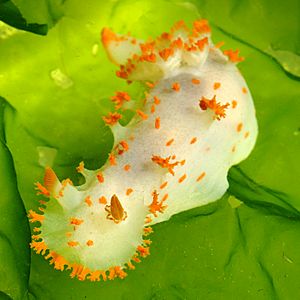Polyceridae facts for kids
Quick facts for kids Polyceridae |
|
|---|---|
 |
|
| Triopha catalinae in situ, head at lower left | |
| Scientific classification |
|
| Kingdom: | Animalia |
| Phylum: | Mollusca |
| Class: | Gastropoda |
| Subclass: | Heterobranchia |
| Clade: | Euthyneura |
| Clade: | Nudipleura |
| Order: | Nudibranchia |
| Suborder: | Doridina |
| Superfamily: | Polyceroidea |
| Family: | Polyceridae Alder & Hancock, 1845 |
| Genera | |
|
See text. |
|
The Polyceridae are a family of amazing sea slugs! They are a type of nudibranch, which are colorful, soft-bodied mollusks that live in the ocean. Think of them as snails without shells. These cool creatures are found all over the world in different marine environments.
Contents
What are Polyceridae?
Polyceridae are a group of marine animals. They belong to a larger group called gastropods. This means they are related to snails and slugs. Unlike most snails, sea slugs in this family do not have a shell. They are known for their bright colors and interesting shapes.
How Scientists Classify Them
Scientists use a system to group living things. This helps them understand how different animals are related. The Polyceridae family is part of a bigger group called Doridacea. This group includes many different kinds of nudibranchs. These nudibranchs are all part of an even larger group called Nudipleura.
Within the Polyceridae family, scientists have found several smaller groups. These are called subfamilies. Each subfamily contains different types of sea slugs. Some of these subfamilies are:
- Kalinginae
- Kankelibranchinae
- Nembrothinae
- Polycerinae
- Triophinae
Different Kinds of Polyceridae
The Polyceridae family has many different kinds of sea slugs. Each kind is called a genus. Think of a genus as a smaller group within a subfamily. Here are some examples of the different genera you might find:
Subfamily Kalinginae
- Kalinga: This is an important genus in this subfamily.
Subfamily Nembrothinae
This subfamily includes some very colorful and well-known sea slugs.
- Nembrotha: These sea slugs are often brightly colored. They are very popular with underwater photographers.
- Roboastra: These slugs are known for being predators of other sea slugs.
- Tambja: These are also very colorful and often have unique patterns.
Subfamily Polycerinae
This is another large group with many different types of sea slugs.
- Gymnodoris: These slugs often have a smooth body.
- Palio: These are smaller sea slugs.
- Polycera: This is a very important genus. It gives the Polyceridae family its name.
- Thecacera: These slugs have interesting horn-like structures on their backs.
Subfamily Triophinae
This subfamily also contains many unique sea slugs.
- Kaloplocamus: These slugs often have branched structures on their bodies.
- Limacia: These are usually smaller and have a fuzzy look.
- Plocamopherus: These slugs can sometimes glow in the dark!
- Triopha: This genus includes the Triopha catalinae shown in the picture.
See also
 In Spanish: Polyceridae para niños
In Spanish: Polyceridae para niños

